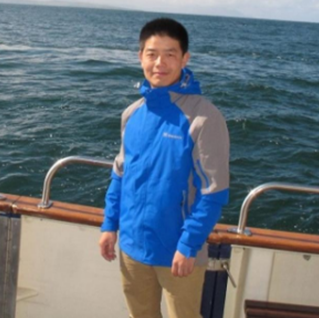
龚承林,男,教授,博士生导师,2014年获中国天天色天天(北京)博士学位、2014年至2017年在美国得州大学奥斯汀分校从事博士后研究;荣获中国地质协会沉积地质专业委员会第一届中国孙枢奖、国际沉积学家协会(IAS)第二届国际孙枢奖(全球每2年评选1次,每次评选2人)、第19届侯德封矿物岩石地球化学青年科学家奖和中海石油(中国)有限公司2023年度勘探优秀外协团队。
任AAPG Bulletin和Journal of Sedimentary Research副主编(Associate Editor)、《沉积学报》执行副主编、第十一届中国地质学会沉积地质专业委员会委员和《古地理学报》编委。
主要从事地震解释、深水沉积与层序源汇方面的教学和科研工作;专注于深海沉积过程及其资源效应的深水沉积学研究,在深海沉积过程和深水源汇系统方面取得系列创新成果。针对深海沉积过程:揭示了重力流与底流相互作用的沉积模式,突破了深海沉积过程的沉积机制,开拓了深海油气勘探新领域。针对深水源汇系统:揭示了深水源汇系统的过程响应与驱动机制,提出了陆架边缘多元耦合控砂机制,揭示了华南-珠江口盆地源汇过程及其物源-构造-气候响应。以第一或通讯作者在《Geology》(3篇)、《GSA Bulletin》(4篇)、《Earth-Science Reviews》(2篇)、《Basin Research》(3篇)、《AAPG Bulletin》(5篇)、《Sedimentary Geology》(6篇)、《Journal of Sedimentary Research》(3篇)和《Sedimentology》等国际重要刊物上发表论文42篇(自然指数刊物4篇、一区Top刊物9篇),研究成果得到国内外同行较高评价、被《Geology》等SCI刊物引用1000余次。主编国际通用沉积学教材《Reading’s Sedimentary Environments》(第三版由前IAS主席主编)第四版第六章,以第一作者出版专著1部(科学出版社)、教材1部(石油工业出版社)。作会议邀请报告6次、担任会议召集人9次,获教育部科技进步奖一等奖和二等奖各1项。主持自然科学基金项目2项,企业横向课题近20项;获发明专利3项。
Email:chenglingong@cqsbzx.com, chenglingong@hotmail.com 电话:18810061083
1. 团队建设与研究生培养
课题组现有博士研究生6人、硕士研究生13人;已毕业博士3人(高等院校2人、中石油1人)、硕士9人(硕博连读3人、读博1人、中石油2人、中海油1人、中石化1人)。与美国得州大学奥斯汀分校Ronald J Steel教授(博士后合作导师)课题组有实质的合作关系,可以为有志于从事“深水沉积、层序源汇与地震解释”相关研究的同学提供良好的科研平台和发展机遇。热忱欢迎有志于学术和深水沉积研究的同学加入课题组,愿同同学们一道探索深水沉积学奥秘、尽我所能愿做春泥、甘为人梯。
2. 科研项目
在研项目:
(1)南海油气成藏机制与勘探开发关键技术(2025ZD1402700)课题2专题3(2025ZD1402703),琼东南盆地深水区伸展构造-沉积动力相互作用及规模砂体形成机制,2025-2030,主持
(2)中海石油(中国)有限公司天津分公司课题,渤海中南部明下段沉积体系演化规律与规模性砂体发育模式研究,2024-2025,主持
(3)中海石油(中国)有限公司上海分公司课题,平湖斜坡带平湖组地震沉积学优化研究,2025-2026,主持
结题项目:
(1)国家自然科学基金面上项目,珠江峡谷末次冰期以来浊流活动对气候变化的响应尺度与反馈机制(41972100),2020-2023,主持
(2)国家自然科学基金青年科学基金项目,中更新世以来珠江陆架边缘三角洲-海底扇“源-汇同步”的形成机制(41802117),2019-2021,主持
(3)中海石油(中国)有限公司海南分公司课题,“顺德凹陷构造-沉积特征及成藏条件研究”中的“专题2:顺德凹陷沉积充填及优质烃源岩和储盖组合分布”,2023-2024,主持
(4)中海石油(中国)有限公司海南分公司课题,琼东南盆地深水区重点区带优质储层分布预测,2023-2024,主持
(5)中海石油深海开发有限公司课题,白云凹陷珠江组陆架坡折带差异控砂机理与岩性圈闭发育条件研究,2023-2023,主持
(6)中国石油化工股份有限公司上海海洋油气分公司,49/09区块梅山组海底扇发育模式及沉积微相研究,2023-2023,主持
(7)中国石油化工股份有限公司石油勘探开发研究院课题,菩提瓜尔盆地深水浊积体系及浊积砂体储层预测,2021-2023,主持
(8)中石油南方公司课题,福山凹陷重点领域综合地质研究与预探目标评价,2021-2023,主持
(9)中海石油(中国)有限公司海南分公司课题,琼东南盆地中央峡谷水道壁特征及其控藏作用研究,2022-2022,主持
(10)中海石油(中国)有限公司天津分公司课题,渤南低凸起北部古近系岩性圈闭分布、成藏机理分析及有利区带预测,2020-2022,主持
(11)中国石油化工股份有限公司石油勘探开发研究院课题,南大西洋盐构造演化及其对上覆沉积的控制—以下刚果盆地为例,2019-2020,主持
(12)中石油杭州地质研究所课题,深水水道-天然堤体系复合体沉积储层分布模式与形成机制研究,2019-2020,主持
(13)中海石油(中国)东海石油天然气作业公司课题,西湖凹陷杭州斜坡带古近系成藏条件及勘探方向研究,2018-2019,主持
3. 代表性科研成果(* = 通讯作者)
专著教材:
(1)龚承林,王英民,2023. 深海重力流与底流交互作用. 北京:科学出版社,2023:1-240(316千字).
(2)王英民,龚承林. 地震解释原理与应用. 北京:石油工业出版社,2023:1-344(560千字).
(3)Gong, C., Li, S., Steel, R.J., Yu, X., Buatois, L.A., Zhu, X., 2023. Lake Environments. In: Levell, B.K., Johnson, H., (Eds.), Reading’s Sedimentary Environments: Processes, Facies and Stratigraphy, 4th Edition (国际通用沉积学教材,第三版由前国际沉积学会主席Harold Reading教授主编).
发明专利:
(1)龚承林,彭旸. 深海水道储层快速评价方法、装置及计算机设备(发明专利),专利号:ZL 2021 1 1262807.9
(2)龚承林,李东伟. 源汇系统物源区定量恢复方法和系统(发明专利),专利号:ZL 2022 1 1395689.3
(3)龚承林,刘濮毓,李东伟. 无井约束确定深水扇富砂区的方法与系统(发明专利),专利号:ZL 2022 1 0288022.7
学术论文:
(1)龚承林*,徐长贵,尤丽,2024. 深海重力流与底流交互作用的沉积响应及其勘探意义.矿物岩石地球化学通报, v. 43 (04): 721-733.
(2)徐长贵,龚承林*,2023. 从层序地层走向源汇系统的储层预测之路.石油与天然气地质, v. 44 (03), p. 521-538.
(3)龚承林*,齐昆,徐杰,刘喜停,王英民,2021. 深水源-汇系统对多尺度气候变化的过程响应与反馈机制.沉积学报, 39 (01), p. 231–252.
(4)Li, Y., Gong, C*., Qiu, X., Colin, C., Barbarand, J., Li, D., Ge, D., 2025. Limited Effect of the Pearl River on the Pearl River Mouth Basin Before the Early Miocene. Basin Research, v. 37: e70045.
(5)Xu, C., Gong, C*., Steel, R.J., Zhang, X., Guan, D., Li, D., 2025. Predicting the occurrence and development of regionally extensive sublacustrine fans in the Oligocene Bohai Bay Basin: From sequence stratigraphy to source-to-sink systems. AAPG Bulletin, v. 109, p. 307–334.
(6)Li, Y., Gong, C*., Qiu, X., Breitfeld, H.T., Barbarand, J., Colin, C., 2024. Provenance history of the eastern Pearl River Mouth Basin: Implications for the evolution of the South China margin. GSA Bulletin, v. 136, p. 5191–5207.
(7)Li, Y., Gong, C.*., Peng, G., Qiu, X., Steel, R.J., Xiao, Z., He, Y., Qi, K., Yu, Y., 2023. Detrital zircon signals of the late Eocene provenance change of the Pearl River Mouth Basin, northern South China Sea. Sedimentary Geology, v. 451, p. 106409.
(8)Gong, C*., Li, D., Steel, R.J., 2023. Sediment waves control origins of submarine canyons: COMMENT. Geology, v. 48, p. 562–562.
(9)Li, D., Gong, C*., Fan, G., Steel, R.J., Ge, D., Shao, D., Ding, L., 2023. Morphological and architectural evolution of submarine channels: An example from the world’s largest submarine fan in the Bay of Bengal. Marine and Petroleum Geology, v. 155, p. 106368.
(10)Qi, K., Gong, C*., Zhang, J., Andresen, K.J., Jin, Z., 2022. Relative sea-level control on the building of two distinct shelf-margin clinothems on the late-Quaternary Pearl River margin: Insights from numerical stratigraphic forward modelling. Basin Research, v. 35, p. 842–864.
(11)Gong, C*., Steel, R.J., Qi, K., Wang, Y., 2021. Deep-water channel morphologies, architectures, and population densities in relation to stacking trajectories and climate states. GSA Bulletin, v. 133, p. 287–306.
(12)Gong, C*., Li, D., Steel, R.J., Peng, Y., Xu, S., Wang, Y., Yu, Y., 2021. Delta-to-fan source-to-sink coupling as a fundamental control on the delivery of coarse clastics to deepwater: Insights from stratigraphic forward modelling. Basin Research, v. 33, p. 2960–2983.
(13)Gong, C., Steel, R.J., Wang, Y., 2020. Channel-levee evolution in combined contour current–turbidity current flows from flume-tank experiments: COMMENT. Geology, v. 48, p. 507-507.
(14)Gong, C*., Sztanó, O., Steel, R.J., Xian, B., Galloway, W., Bada, G., Qiang, X., 2019. Critical differences in sediment delivery and partitioning between marine and lacustrine basins. GSA Bulletin, v. 131, p. 766–781.
(15)Gong, C*., Blum, M.D., Wang, Y., Lin, C**., Qiang, X., 2018. Can climatic signals be discerned in the deepwater sink?: An answer from the Pearl River sediment-routing system. GSA Bulletin, v. 130, p. 661–677, doi.org /10.1130 /B31578.1.
(16)Gong, C., Wang, Y., Rebesco, M., Salon, S., Steel, R.J., 2018. How do turbidity flows interact with contour currents in unidirectionally migrating deep-water channels? Geology, v. 46, p. 551–554.
(17)Gong, C*., Peakall, J., Wang, Y., Wells, M.G., Xu, J., 2017. Flow processes and sedimentation in contourite channels on the northwestern South China Sea margin: A joint 3D seismic and oceanographic perspective. Marine Geology, v. 393, p. 176–193.
(18)Gong, C., Wang, Y., Steel, R.J., Peakall, J., Zhao, X., Sun, Q., 2016. Flow processes and sedimentation in unidirectionally migrating deep-water channels: From a 3D seismic perspective. Sedimentology, v. 63, p. 645–66.
(19)Gong, C*., Steel, R.J., Wang, Y., Lin, C., Olariu, C., 2016. Shelf-margin architecture variability and its role in sediment-budget partitioning into deep-water areas. Earth-Science Reviews, v. 154, p. 72–101.
(20)Gong, C*., Steel, R.J., Wang, Y., Lin, C., Olariu, C., 2016. Grain size and transport regime at shelf edge as fundamental controls on delivery of shelf-edge sands to deepwater. Earth-Science Reviews, v. 157, p. 32–60.
(21)Gong, C., Wang, Y., Steel, R.J., Olariu, C., Xu, Q., Liu, X., Zhao, Q., 2015. Growth styles of shelf-margin clinoforms: Prediction of sand- and sediment-budget partitioning into and across the shelf. Journal of Sedimentary Research, v. 85, p. 209–229.
(22)Gong, C., Wang, Y*., Pyles, D.R., Steel, R.J., Xu, S., Xu, Q., Li, D., 2015. Shelf-edge trajectories and stratal stacking patterns: Their sequence-stratigraphic significance and relation to styles of deep-water sedimentation and amount of deep-water sandstone. AAPG Bulletin, v. 99, p. 1211–1243.
(23)Gong, C., Wang, Y., Zhu, W., Li, W., Xu, Q., 2013. Upper Miocene to Quaternary unidirectionally migrating deep-water channels in the Pearl River Mouth Basin, northern South China Sea. AAPG Bulletin, v. 97, p. 285–308.
(24)Gong, C*., Wang, Y., Peng, X., Li, W., Qiu, Y., Xu, S., 2012. Sediment waves on the South China Sea Slope off southwestern Taiwan: Implications for the intrusion of the Northern Pacific Deep Water into the South China Sea. Marine and Petroleum Geology, v. 32, p. 95–109.
(25)Gong, C*., Wang, Y., Zhu, W., Li, W., Xu, Q., Zhang, J., 2011. The central submarine canyon in the Qiongdongnan Basin, northwestern South China Sea: Architecture, sequence stratigraphy, and depositional processes. Marine and Petroleum Geology, v. 28, p. 1690–1702.

